| |
|
|
|
|
Woolpit is perhaps
the most perfect of all Suffolk villages. Not
particularly sleepy, and only a little chocolate boxy,
but somewhere that people actually live. Its shops,
museum and pub are arranged around the pleasant village
square, and Phipson's crazy spire of St Mary's church
rises above them. Woolpit still has its school, and you
wouldn't need to get in the car every time you needed to
go shopping like you would in some of Suffolk's more
famously picturesque villages. And then there is the
Woolpit of myth, of the two green children who climbed
out of the ground, speaking a strange language and afraid
of the sunlight. The boy died soon after, but the girl
grew up and married. She learned to speak English, and
told stories of St Martin's Land from where she and her
brother had emerged. There are holes in the ground around
Woolpit, quarries where bricks were made in the 19th
Century. But perhaps there was once something much older,
for as every local schoolchild knows, the name 'Woolpit'
is nothing to do with wool, but with the wolves which
once haunted the pits here...
Your first sight of St Mary will be diocesan surveyor
Richard Phipson's 1870s spire, visible from miles away,
and quite unlike anything else in East Anglia. Suffolk is
a county where spires are rare enough anyway. From the
far side of the Gipping valley you can see this one and
two others, piercing the soft harvest mist in autumn.
They are Phipson's equally absurd spire at Great
Finborough, and then the 1990s blade of St Peter and St
Mary, Stowmarket. There are only about a dozen more
church spires in the whole of the county. The excuse for
this one was that the tower had been struck by lightning
in 1852, bringing down the previous lead and timber
affair (presumably similar to the one at Hadleigh).
In the 1950s and 1960s the artist John Piper produced a
series of screen prints of views of Suffolk churches. For
most he used the fine perpendicular tower, typical of the
county, ramifying it in bold Festival of Britain primary
colours. But for Woolpit he chose the porch, because it
is Suffolk's finest. Cautley thought it was the best in
all England. As with the contemporary porch at Beccles,
it rises way above the south aisle, and is tower-like in
itself.
Wills of the 15th and
16th Centuries found by Peter Northeast and Simon Cotton
give a fairly clear idea of the sequence of construction
of the building. Ralph Howden, clerk in 1420 left 12d
to the building of the nave, and then ten years
later John Brumpton, the rector, asked in his will to
be buried in the chancel and left 5 marks to the
building of the porch, thus indicating that by this
date the nave, chancel and south aisle must have been
pretty well complete. Thereafter a succession of wills
bequeathed money to the building of the porch until 1462,
at which date John Skeppere the Elder left 13s 4d (which
is to say two nobles) to the emendation of the said
church on the north side, which is to say the
construction of a north aisle. Work on the porch had
perhaps been completed by 1474 when the rector John
Lynton left the remarkably large amount of £20 for
five statues to fill the niches. The last mention of
the north aisle is in 1500, when John Cooke's somewhat
convoluted will stated that I bequeth toward the
makyng of the northe eele of the church of Wulpet x marcs
under this condicion if WIlliam Abrey of Wulpett make the
foresaid eele with inne the space of ii years after the
date of this my will or ellys the said x marcs to be at
the disposicon of myne executors. Whether or not the
aisle was made within the space of two years can't be
known, but there are no further bequests to it, and it is
certainly there today.
You step into a cool
expanse of clear light thanks to the lack of coloured
glass in the nave. There is a feeling of gravitas, of
dark wood, tiles and stone. And resist for as long as you
might, at last you look up. It is breathtaking. This is
Suffolk's most perfectly restored angel hammerbeam roof.
It may not have the drama of Mildenhall, the
exquisiteness of Blythburgh, the sheer mathematics of
Needham Market, but it shows us in detail more than any
other church roof in the Kingdom what the medieval
imagination was aiming at. From the still, small silence
of the church floor below, you look up into a great shout
of praise. Here are hundreds of figures, both angelic and
human. The profusion is ordered, as if some mighty hymn
were in progress, for roofs like this shout as loud as
the Te Deum Laudamus: We praise thee, O God, we
acknowledge thee to be the Lord... To thee all Angels cry
aloud, the Heavens, and all the Powers therein. To thee
Cherubim and Seraphim continually do cry Holy Holy Holy
Lord God of Sabaoth... The glorious company of the
Apostles praise thee, the goodly fellowship of the
Prophets praise thee, the noble army of Martyrs praise
thee...
The wall posts contain saints and prophets, some with
symbols, some with books, and some with martyr's palms.
There are angels on the wallposts and hammerbeams above,
and angels bearing symbols below. John Blatchly counted
128 angels altogether. Some of the shields have letters
on them. Are they an acrostic, as on the east chancel
wall at Blythburgh? Do they represent the names of the
saints? The great Henry Ringham completely restored this
roof in the 1840s, and the angels are his, but Mortlock
thought that the angel in the south-west corner of the
nave was not his, but is the surviving original from
which he worked. This seems likely, and we might assume
that many other damaged angels were removed to allow for
their replacements based on this one. Ringham's workshop
in St John's Road, Ipswich employed fifty men, but even
so this great church must have kept them busy for a good
while.
  
  
   
 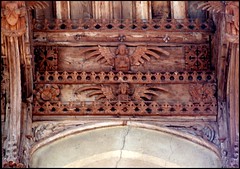 
Ringham's restoration
was of a roof which at some point had been badly damaged,
its imagery largely excised. One instinctively thinks of
the iconoclast William Dowsing, the puritan inspector of
the churches of Cambridgeshire and Suffolk, who
progressed through many of the churches of the two
counties during the course of 1644 ensuring that
'superstitious' imagery was removed. Angel roofs were one
of his particular targets, not least because many of them
had escaped the attentions of the protestant reformers of
a century earlier, probably because they were
inconvenient to deal with being so high up. Dowsing
didn't visit Woolpit church in person, but his deputy
did, and this was probably Thomas Denny. He arrived here
on the afternoon of February 29th 1644. It was a
Thursday, and the pair may have come together across
country from Helmingham, where they had found much to do.
Dowsing planned to visit Beyton church that day, but in
the end stayed overnight at the Bull hotel where he may
have written up his deputy's account of the visit to
Woolpit, before inspecting All Saints, Beyton in the
morning. He then rested for the weekend, probably in Bury
St Edmunds. The following week he had a busy tour of
southern Cambridgeshire ahead of him.
Dowsing records in great detail in his journal what was
done, and what needed to be done, at each church. In the
case of Woolpit, the angel roof is 'the dog that didn't
bark' in what is a surprisingly brief entry for such a
large church. Dowsing writes: My deputy. 80
superstitious pictures; some he brake down, and the rest
he gave order to take down; and three crosses to be taken
down in 20 days. 8s 6d. The 8s 6d was a noble, and
this was Dowsing's charge for his advice. It's worth
remembering that most churchwardens and ministers would
have been supportive of Dowsing and the puritan project.
Sometimes Dowsing waived the charge if he felt an honest
effort had been made before his arrival, but either he or
his deputy did not apparently think that this was the
case at Woolpit. In any case, the charge was worth paying
to avoid the fine of 20s for non-compliance, and it is
likely that many churchwardens, and perhaps even some
ministers, would not have been theologically articulate
enough to be sure of what they needed to do. The superstitious
pictures that Dowsing mentions were in stained glass
and had probably survived the Reformation of a century
earlier. The crosses were most likely on the outside of
the building, and that there were three suggests that
they were gable crosses on nave, chancel and porch.
And yet, he doesn't
mention the roof. Given that it would have been cause for
considerable offence, there are only two possible
reasons. Either his deputy didn't notice it, or the
angels had already been vandalised. This second option
seems more likely. Mid-Suffolk was a strongly protestant
area, and nearby Rougham church, which seems to have had
a similar roof, was not visited by Dowsing, but its roof
was vandalised even more comprehensively than the roof at
Woolpit. Dowsing appears to have not bothered to visit
any churches where he knew action was likely to have been
taken, and these would have mostly been churches with
ministers supportive of the puritan cause. Most likely,
the destruction at both churches dated from a hundred
years earlier than Dowsing's visit, although it is not
impossible that the Rougham and Woolpit congregations had
been puritan enough in the 1630s to do it to their own
churches themselves. It may well be that Dowsing only
directed his deputy to visit Woolpit because it happened
to be on their journey from Helmingham towards Beyton.
Beneath the roof, the church is broad, its two aisles
giving room for the panoply of medieval liturgical
processions. The plain, simple font is the early 20th
Century work of Ninian Comper, which might suggest that
the old font was damaged by the fall of the spire fifty
years earlier, and they'd decided to replace a 19th
Century font with something more appropriate. At the east
end of the south aisle was once the shrine of Our Lady of
Woolpit, Suffolk's most important site of medieval
pilgrimage after the Shrine of Our Lady of Grace at
Ipswich. But it is the range of benches in the nave that
capture a visitor's attention now. The bench ends of
Woolpit are remarkable for their abundance, and also for
the fact that they are largely not representations of
sacraments, virtues and vices as at Tannington and
elsewhere, or of Saints as at Ufford and Athelington, or
indeed of mythical beasts at so many East Anglian
churches. They are almost all non-allegorical animals.
Some are 15th Century, others are 19th Century copies.
Perhaps a good comparison is with the similar, albeit
restored, body of work at nearby Combs. Indeed, although
they do not appear to be from the same workshop, it is
likely that their creators knew of each others' work.
There are dogs with geese hanging from their mouths, and
another which may be a cat with a rat or lizard. There
are lions and bears, and a chained monkey, and birds in
profusion.
  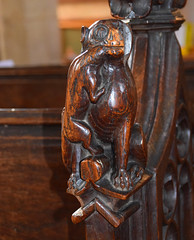 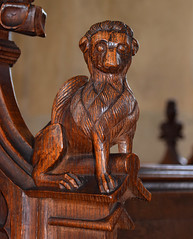
 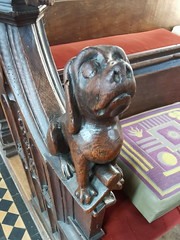 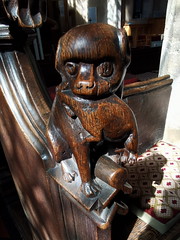 
  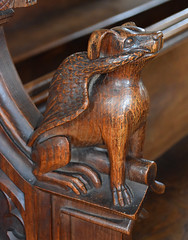 
So who made them, and
why are they here? There is one school of thought that
says that they are simply there to beautify the church,
and that they were made by local craftsmen doing what
they were best at. If they could do lions, they did
lions. If they could render a decent rabbit, then that is
what they did. And so on.
But perhaps there is more to it than that. Many years
ago, shortly before a visit to Woolpit, I had spent an
afternoon in one of my favourite towns, Autun, in
Burgundy. One of the reasons I like Autun is its 11th
century Cathedral of St-Lazaire: this is Lazarus,
raised by Christ from the dead, and until the 18th
Century his relics were venerated at the shrine there.
St-Lazaire is most famous for its tympanum above the west
door, generally recognised as one of the greatest
Romanesque art treasures in the world, and with
International Heritage status. It was created during the
middle years of the 12th Century, and shows the Last
Judgement. To emphasise Christ's majesty over all the
world it features all manner of beasts, domestic, wild
and mythical. Throughout the Cathedral, animals wander
and wind around the famous capitals, which tell the
Gospel story. Abbe Denis Grivot, in his Un Bestiaire
de la Cathedrale D'Autun (Lyon, 1973) argues that
the 12th Century creators of all this work filled it with
animals to echo the final verse of the 150th Psalm, the
crowning point of that great sequence of hymns of praise:
Let everything that hath breath praise the Lord!
Looking up into the roof at Woolpit I was reminded of
this, and of words of the Te Deum Laudamus. The Te Deum
is one of the canticles, and another is the Benedicite,
traditionally sung through Lent: Oh all ye Works of
the Lord, bless ye the Lord; praise him and magnify him
for ever... O ye whales, and all that move in the Waters,
bless ye the Lord... O all ye Fowls of the air, bless ye
the Lord... O all ye beasts and Cattle, bless ye the
Lord: praise him, and magnify him for ever! Could it
be that the angel roof and bench ends at Woolpit, and
elsewhere in East Anglia, were intended to reflect and
represent the praise declared in the canticles and
psalms? Both would have been central to the liturgy of
the medieval Catholic church. Perhaps the bench ends of
Woolpit are liturgical and theological after
all.
How would a carpenter, or group of carpenters, go about
creating a set of benches like the ones at Woolpit? Who
were they? Almost certainly, they were locals. They might
have been itinerant jobbing carpenters, but I don't think
so. The bench ends at adjacent Tostock are clearly by the
same hand. But those at nearby Stowlangtoft and Norton
are not, and a third hand seems to be responsible for
those at Combs, as I previously mentioned. I do not think
that the mutilated ones at Rougham and Elmswell are by
the Woolpit carvers either, and they were probably from
the same workshop as each other. So, perhaps what we are
seeing is a conscious attempt by skilled members of a
community to create in their church a hymn of praise in
carved oak, by representing as many beasts as they felt
capable of making. Where did they get their ideas from?
They would have had no problems with oxen, cocks, conies
- these were all around them, in their daily lives. The
person who carved the hunting dog here was very familiar
with it. Perhaps it was his own. What about monkeys and
lions? These are more problematic. In medieval
bestiaries, exotic creatures had fabulous legends
attached to them, which gave them a theological
symbolism. But this symbolism doesn't usually seem
intended when we see them on bench ends. Sometimes wild
animals are rendered accurately, but more often they are
creatures of the imagination. Think of Barningham's
camel, Dennington's giraffe, Denston's elephant. It isn't
enough to say that the carvers could have seen pictures
of exotic beasts. This is fairly unlikely. Probably, the
ordinary people of Woolpit never saw a book other than
the missals, lectionaries and hagiographies used in
church.
They might have seen pictures of lions and monkeys in
wall paintings, either in other churches or here at
Woolpit. They might have seen them carved in bench ends
elsewhere, for the same reason. In fact, the
representation of wild animals varies so much as to
suggest that this is not the case - compare, for example,
the lions of Combs with those of Stowlangtoft. Probably,
they were created in the imagination from descriptions
and attributes in stories. But I think that there is a
strong possibility that the woodcarvers of Woolpit did
see lions and monkeys in real life.
Even today, in more remote parts of Europe there are
still villages which, by virtue of being so very far from
each other, take on a rich and complex life of their own.
Even smaller villages may have their shops, their
craftsmen, their tradespeople. They replicate a situation
that must have existed in Suffolk until well into the
19th Century, and in some cases beyond, before the great
industrialisation swept it all away. Further, there are
traditions which survive in such places that we have
lost. Even today, itinerant entertainers move from
village to village, giving a single performance before
moving on. This must also once have been true of England.
And perhaps most fascinating of all are the small family
circuses and travelling menageries. Mostly they seem to
be of Italian or Romany origin. They put up their tent
immediately before the performance, and take it down
straight away afterwards. The caged animals are coupled
up to cars and vans, and they move on, through the remote
hills of Provence and Ruthenia, of Galicia and
Transylvania, performing and displaying on village
greens, waste grounds, the corners of fields, even
traffic islands.
I do not know if such travelling circuses and menageries
existed in medieval Suffolk. But I think that they
probably did. Suffolk is a maritime county, and exotic
animals were widely known and exhibited in medieval
Europe. Before the Protestant Reformation cut us of from
the mainland, clerics and merchants thought of themselves
as European, and travelled widely - English sovereignty
was a hazy concept at best, and 'Britishness' was still
centuries away from being formulated as an idea. People
owed allegiance to their husband or wife, their village,
their parish, and their lord, not to the Crown and
Parliament in London.
Were the woodcarvers of Woolpit and Tostock remembering
this? A circus visit, perhaps back in their childhood?
Exotic animals rendered inaccurately, to be sure, but
with an enthusiastic nostalgia for that exciting moment
in their lives? Was there a lion? A monkey, or a bear?
How much more powerful if they also knew the fabulous
legends about the beasts - and had seen them in real
life! Having said that, some of the carvings at Woolpit
clearly are allegorical. One shows a monkey
dressed in monk's robes. This, I think, is a joke at the
expense of the itinerant friars who went from parish to
parish, preaching repentance in the streets. They were
sanctioned by the Pope, but were beyond the jurisdiction
of the local bishop. They didn't always go down well with
the local priest and congregation, who considered the
friars to be nosey and hypocritical. A monkey was a
symbol of foolish vanity - hence, a friar thinking he was
better than anyone else. What better way to make the
point than to slip him in as one of the creatures
praising the Lord?
How did they survive? But why should they have been
destroyed? We make the mistake of thinking of the
Puritans as vandals. But the more you read about William
Dowsing, the more he emerges as being a principled,
conservative kind of chap, despite his fundamentalist
theological opinions. He had no reason to destroy animal
bench ends. They weren't superstitious - even Dowsing
didn't think Catholics worshipped animals. If he didn't
know they were meant to represent the canticles, he
wouldn't even have considered them religious. Amen to
that.
So much for the 17th Century. What about the 19th? St
Mary is one of the more enthusiastically restored of
Suffolk's larger churches, but it was generally done
well. Mortlock thought that the 19th Century pulpit was
also the work of Ringham, though Pevsner attributes it to
George Gilbert Scott's workshop. The brass lectern is
pre-Reformation, a fine example. The rood screen dado
panels have sentimental 19th Century Saints on them, that
may or may not replicate what was there before. They have
their names painted on the base for the less
hagiologically articulate Victorian worshipper. From left
to right across the aisle they are St Barbara, St Felix,
St Mary Magdalene, St Peter, St Paul, Blessed Virgin
Mary, St Edmund and St Etheldreda. It is unlikely that St
Felix would have been on the medieval roodscreen, and the
Blessed Virgin almost certainly wasn't, for it would have
relegated her to a position of no more importance than
the others. If it reflects anything of what was there
before, it was probably St Anne with the infant Virgin.
 
The top part of the
screen was renewed in 1750, and it is dated so. The gates
are probably a Laudian addition of 120 years earlier, as
at Kedington. This may suggest that, by the time of
Dowsing's deputy's visit, the chancel was being used for
some other practical purpose. Above, high above, set in
the east nave wall over the chancel arch, is one of the
weirdest objects I've ever seen in a medieval church. It
was installed in the 1870s, and is clearly meant to echo
the coving of a rood loft. Goodness knows what it
actually is, but it is painted in garish colours, and
inscribed with texts. In one of those moments where
Cautley and credibility briefly part company, he
describes anyone who doesn't think it is a genuine
medieval canopy of honour as 'stupid'. I suppose that it
has a certain curiosity value.The three-light window
above it would have given light to the rood.
All the coloured glass
in the church is in the chancel. The Blessed Virgin and
child in the east window was by Ian Keen for the King
workshop in the early 1960s, who rearranged the 19th
Century glass around it. The shields and the roundels
successfully echo a few 15th Century angel survivals in
the upper lights set among later replacements. Other 15th
Century survivals in the chancel include a running stag
and a sleeping dragon, and a series of saints who might
well be the early 19th Century work of the Lowestoft
painter Samuel Yarrington.
One of the stalls in
the chancel has a late medieval finial depicting the
three Marys. The Blessed Virgin Mary, Mary Salome and
Mary Magdalene huddle together, perhaps on the morning of
the Resurrection. The Blessed Virgin holds a lily of the
Annunciation. This is a delight, and you'd travel to
London to see it if it was in the V&A. One head is
destroyed - but was it vandalised? Or is it more likely
the result of carelessness, the wear and tear of the
centuries? Dowsing rarely mentions seeming any bench
ends, and it seems likely that any medieval benches which
had survived the attention of the protestant reformers of
a century earlier would have been boxed in by the 17th
Century, for the sake of fashion as much as for anything
else. But how could it possibly have survived the violent
zeal of those 16th Century Protestants, battering the
Church of England into existence with their axes, pikes
and bonfires? How, even after the edicts of the 1530s and
1540s which ordered the destruction of all statues and
images of saints, especially those of the Blessed Virgin
Mary, is it still there at all? What a fascinating place
a medieval church is!
|
|
|
|
|

